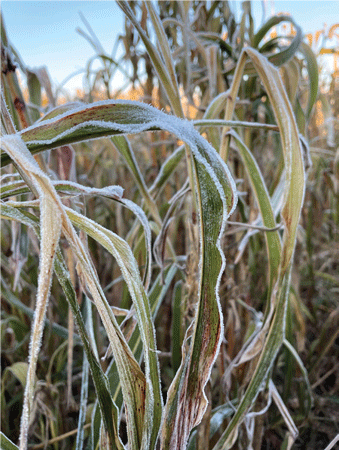Freezing temperatures change plant metabolism and composition, and different forage species respond differently to cold stress as the fall progresses. Still, damaging frosts significantly reduce forage quality in most forage species. Depending on plant species, these changes in metabolism resulting from freezing temperatures can create possible feeding-related animal disorders, and therefore, there may be a need to alter grazing management.
Prussic acid poisoning
Plants that contain cyanogenic glucosides, such as warm-season annual grasses in the sorghum family, produce larger amounts of cyanide (prussic acid) when damaged by frost (Figure 1). Greater potential for harmful cyanide levels occur in soils with nitrogen content and low in phosphorus or potassium.
Consuming large amounts of prussic acid interferes with oxygen utilization, potentially causing animals to die from asphyxiation (respiratory paralysis). Symptoms such as cherry-red colored blood, staggering, difficulty breathing, spasms, foaming at the mouth, excess salivation, falling, and severe convulsions appear rapidly after forage consumption, sometimes leading to animal death within minutes.

Figure 1. Mid-October morning freeze on sorghum-sudangrass. Photo from K-State Research and Extension MF3607.
It is extremely important to use caution when grazing these species during the fall. Most toxins are produced within hours of a freeze event, so grazing animals should be removed from the field before a frost or freeze occurs. If there is a killing frost, it is advised to avoid livestock grazing these pastures for up to three days after the frost – as the toxin usually dissipates within 72 hours or until plant tissue is dried out. Fresh forage is riskier as cyanide levels will be higher as compared to dry tissue, silage, or hay. After non-killing frosts, we advise you to wait 10-14 days without additional frost action before grazing.
Prussic acid content decreases significantly when the forage is cut for hay/used for silage, as large amounts are lost as gas during fermentation. Still, it is recommended to delay feeding silage for six to eight weeks following ensiling. Forage cut for hay that contained high concentrations of cyanide before harvest may still have dangerous levels even after drying. Testing is cheap compared to dead cows. Producers can consider mixing nonthreatening forages into the diet to dilute any potentially damaging residual cyanide.
Forages with differing potentials for prussic acid production:
- High: grain sorghum, forage sorghum, and sorghum-sudangrass hybrids
- Intermediate: sudangrass
- Low: piper sudangrass, pearl millet, and foxtail millet
Other species that have the potential to contain toxic levels of prussic acid after frost include Johnsongrass, chokecherry, black cherry, and elderberry. Refer to these publications for more information: Prussic Acid Poisoning and Managing the Prussic Acid Hazard in Sorghum.
Nitrate toxicity
The summer of 2023 was extremely dry in many areas of Kansas. Drought-stressed annual and perennial forages can accumulate toxic nitrate levels. This can be worsened after a frost, as freezing damage slows down metabolism and can accumulate nitrate in parts of the plants that are still growing. Examples of forages that may have high nitrate levels include alfalfa, corn, oats, and other small grains, millet, sudangrass, sorghum sudangrass, Johnsongrass, etc. Before feeding or grazing drought-stressed forage, send a forage sample to a commercial lab to be tested for nitrates. Follow your lab’s specific instructions about how to collect and handle the sample. The cost of sampling and analysis is well below that of losing animals.
For more complete information on nitrate toxicity, see this publication: Nitrate Toxicity.
Managing alfalfa after a hard freeze
If cutting alfalfa for hay, the final cutting should occur right after the first killing freeze, before too many leaves have dropped, to reduce losses in nutritive value. A killing freeze commonly requires temperatures below 25⁰F for more than four hours. Producers should be prepared to enter the fields when soil moisture conditions allow. After a killing freeze, the remaining forage, if any, can be hayed safely. However, the producer should act quickly because the leaves will soon drop off.
If grazing alfalfa fields, the best practice is to wait a few days after the freeze before releasing livestock to the field as frost-damaged alfalfa, while not toxic in terms of prussic acid, does have an increased potential for bloat for a few days. Other forage legumes, such as clovers, also have the potential to cause bloating after a freeze. Bloat chances decrease once wilting starts or the plant starts growing again. Another option is to swath legume pastures ahead of grazing so that animals graze dry hay instead.
Grazing tall fescue after a freeze
Tall fescue has a waxy layer that reduces the damage caused by frosts; consequently, forage quality remains relatively high when compared to other species and can even result in an increase in sugar content, making tall fescue ideal for stockpiling and winter grazing use. Native grass species retain leaves better than annual forages and are better suited for grazing after annual forages.
Romulo Lollato, Extension Wheat and Forage Specialist
lollato@ksu.edu
John Holman, Cropping Systems Agronomist, Southwest Research-Extension Center
jholman@ksu.edu
Sandy Johnson, Extension Beef Specialist, Northwest Research-Extension Center
sandyj@ksu.edu